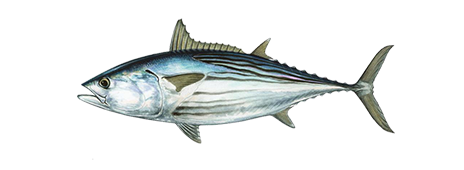Black Skipjack

Black Skipjack
A very sporting fish on light tackle, the black skipjack is rated as a good food fish by some and disdained by others.
HOW TO IDENTIFY A BLACK SKIPJACK
The dorsal fin of this fish has 13-15 spines and is higher in the front of the fin than in the back. This feature distinguishes it from the bonito, Sarda sarda, which has a relatively long and low first dorsal fin. The anal fin, which has 11-13 rays, is similar to the second dorsal fin in size and shape. The body lacks scales, except on the anterior corselet and along the lateral line. This is the only species of Euthynnus that has 37 vertebrae. All others in the species have 39 vertebrae. Each jaw has 20-40 small, conical teeth. Bonitos have fewer and larger conical teeth than the black skipjack and mackerels have flat, triangular teeth. Black skipjacks can be distinguished from similar species by the four or five broad, straight, black stripes which run horizontally along the back and by the dark spots between the pectoral and ventral fins. In live specimens, stripes may be visible on the venter as well as on the back, which has frequently led to confusion from anglers mistaken it for the skipjack tuna, Katsuwonus pelanis. The stripes on the belly rarely persist long after death in the black skipjack; however they remain prominent in the skipjack tuna long after death.
WHERE TO CATCH BLACK SKIPJACK
The black skipjack inhabits tropical and warm temperate waters of the eastern Pacific Ocean from California to Peru, and rarely is found in the central Pacific. The following list includes additional details on where to catch this fish:
Baitfish Patches Bays and Estuaries
Birds Coastal Waters
Deep Shore Water Floating Foam and Debris
Merging Water Night Fishing
Reef, Wreck and Shoals Rocky Sea Floor
The Open Ocean
HOW TO CATCH BLACK SKIPJACK
This species is pelagic, schooling, and migratory, feeding predominantly on small surface fishes, squids, and crustaceans. It can be hooked by trolling or casting small whole or strip baits, or small lures such as spoons, plugs, jigs, and feathers. It has been said that the black skipjack will frequently strike any lure trolled at speeds up to 8-10 miles per hour. Its flesh has a very dark red color and prominent taste. Like most tunas, catches should be immediately bled and iced to maintain the quality of the meat. The following are fishing methods used to catch this fish:
Drift Fishing Fly Fishing
Chumming Bait Casting
Saltwater Trolling Saltwater Jigging